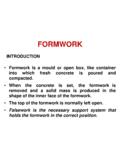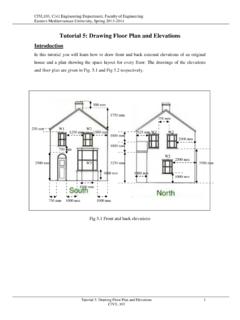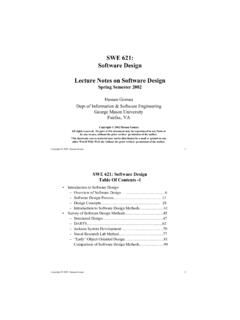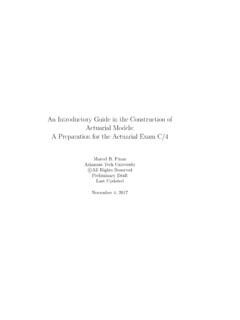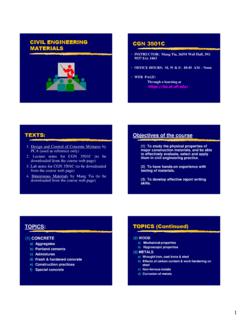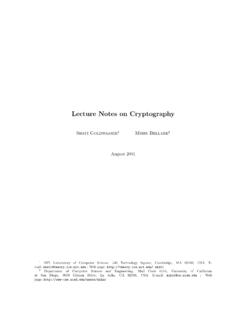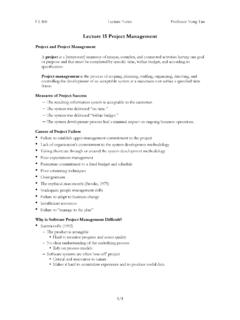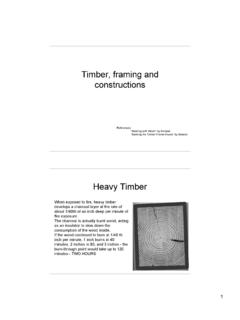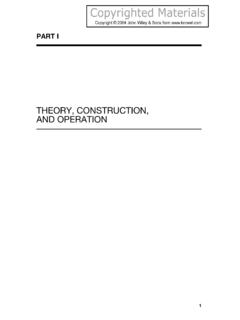Transcription of MATERIALS OF CONSTRUCTION - civil.emu.edu.tr
1 Department of Civil Engineering MATERIALS OF CONSTRUCTION lecture notes Second Edition Prepared by zg r EREN Gazima usa, 2015 CIVL284 The following lecture notes are based on my personal notes accumulated over the past ten years. I accept responsibility for their accuracy, and/or any mistakes which may be present. I accept any criticisms and look forwards to your suggestions for improving this lecture notes . zg r EREN Department of Civil Engineering Eastern Mediterranean University 2015 CONTENTS i CONTENTS Chapter 1. Gypsum Production of Gypsum, 1 Hardening of Gypsum, 2 Properties of Gypsum, 2 Chapter 2.
2 Limes Production of Lime, 3 Practice of Calcinations, 3 Classification of Quicklimes, 3 Hydration, 5 Hydraulic lime, 6 Chapter 3. Cements Introduction, 9 History of Cement, 9 Raw MATERIALS of Portland Cement, 9 Chemical Composition of Portland Cement, 10 Main Chemical Compounds of Portland Cement, 12 Manufacturing of Portland Cement, 13 Production Steps of Portland Cements, 14 Physical Properties of Cement, 16 Types of Cement, 18 ASTM (American Society for Testing and MATERIALS ) Types, 18 Other Types, 20 Chapter 4. Aggregates Introduction, 26 General Classification of Aggregates, 26 Particles Shape and Texture, 28 Mechanical Properties of Aggregates, 31 Bond of Aggregate, 31 Strength of Aggregate, 31 Physical Properties, 32 Specific Gravity, 32 Bulk Density, 32 Porosity and Absorption of Aggregates, 33 Moisture Content of Aggregate, 33 Deleterious Substances in Aggregates, 34 Soundness of Aggregate, 35 Sieve Analysis, 35 Grading Curves, 38 Fineness Modulus, 38 Grading Requirements, 39 Gap-Graded Aggregate, 40 Chapter 5.
3 Fresh Concrete Introduction, 43 Workability, 43 Measurement of Workability, 44 CONTENTS ii Segregation, 48 Bleeding, 49 Mixing Time, 50 Co mpaction of Concrete, 50 Curing of Concrete, 51 Common Techniques of Curing, 51 Selection of Curing Techniques, 52 Quality of Mixing Water, 52 Mixing, handling, placing and compacting concrete, 53 Charging the mixer, 53 Uniformity of mixing, 53 Mixing time, 54 Handling, 54 Pumped concrete, 55 Underwater concreting, 59 Chapter 6. Hardened Concrete Shrinkage, 60 Plastic Shrinkage, 60 Autogenous Shrinkage, 60 Drying Shrinkage, 61 Durability, 62 Factors Affecting Durability, 62 Testing of Hardened Concrete, 63 Compressive Strength, 63 Tensile Strength, 64 Chapter 7.
4 Concrete Mix Design Calculations The workability of concrete, 66 Measurement of workability, 66 Water content, 66 Type and strength class of cement, 67 The compressive strength of concrete, 67 Age at test and curing conditions, 67 Type and strength class of cement, 67 Cement strength variation, 67 Aggregate type and grading, 68 Relationship between compressive strength and free-water/cement ratio, 68 Type of mixing, 69 Variability of concrete strength during production, 69 Factors contributing to the overall variation, 69 The distribution of results, 70 Characteristic strength, 70 Margin for mix design, 71 The Mix Design Process, 72 Flow chart of procedures, 72 Selection of target water/cement ratio (Stage 1), 73 Selection of free-water content (Stage 2), 74 Determination of cement content (Stage 3), 74 CONTENTS iii Determination of total aggregate content (Stage 4), 75 Selection of fine and coarse aggregate contents (Stage 5), 75 Trial mixes, 76 Production of trial mixes, 76 Tests on trial mixes, 77 Adjustments to mix proportions, 78 Examples of mix design, 79 Chapter 8.
5 Bricks Introduction, 93 Manufacturing of Bricks, 93 Mining and Storage, 94 Preparing Raw MATERIALS , 94 Forming, 94 Drying, 95 Glazing, 95 Burning & Cooling, 95 Drawing & Storing, 96 Types of Bricks, 96 Varieties and Functions, 96 Qualities , 96 Types, 97 Mortars, Lime Mortar, 97 Cement Mortar, 98 Cement Lime Mortar, 98 Air Entrained Mortar, 98 Properties of Brick and Brickwalls, 98 Colour, 98 Texture, 98 Size, 99 Strength of Bricks, 99 .5 Water Absorption of Brick, 99 Chapter 9. Building Stone & Masonry Introduction, 101 Types of Natural Building Stones, 101 Production of Finished Stone, 102 Finishes on Stone Slabs & Panels, 104 Stone Selection, 105 Bond Patterns in Stone Masonry Walls, 106 Glass Masonry Units, 108 Fire Resistance of Masonry Walls, 111 Chapter 10.
6 Plasters Introduction, 112 The Plastering Process, 112 Classes of Gypsum Plasters, 112 Lightweight Aggregates, 113 Lime, 113 CONTENTS iv Factors affecting the choice of plaster, 114 Undercoat, 114 Finishing coat, 115 One-coat plasters, 116 Plasterboards, 116 Dry Lining, 118 Common defects in plastering, 118 Cracking, 118 Loss of adhesion, 119 Dry out, 119 Chapter 11. Steel Mechanical properties of metals, 120 Extraction of metals, 122 Carbon content of steel, 124 Types of steel, 124 Corrosion protection, 125 Nonferrous metals, 126 Chapter 12. Wood Strength, 128 Stress Grading, 128 Moisture Content, 129 Timber Seasoning, 129 Air Seasoning, 129 Kiln Drying, 130 Classification of Trees, 130 Manufacturing of Lumber, 131 Softwood Lumber Classification, 131 Hardwood Lumber, 132 Plywood, 133 Manufacturing of Plywood, 133 Chapter 13.
7 Polymers Introduction, 134 Classification, 134 Thermoplastics, 134 Thermosetting Plastics, 135 Chemically Setting Plastics, 135 Types of plastics, 135 Manufacture of organic plastics, 141 Plastics in CONSTRUCTION , 142 References GYPSUM 1 1. GYPSUM Gypsum usually is found in rock formation in nature, as CaSO4(2H2O). It is hydrous calcium sulfate with compounds of lime, sulfur and water. Production of Gypsum Gypsum is rarely found in the pure state but usually contains varying amount of clay, limestone, silica, iron compound, etc. In the pure state it is white, but combined with impurities, it may be grey, brown, or reddish brown.
8 Some deposits of gypsum are found close to the surface of the earth; others well below the surface. Gypsum has been recognised as a valuable building material for several thousand years. Gypsum is a hydrous calcium sulfate with the chemical formula (CaSO4 (2H2O), which means that it is a compound of lime, sulfur, and water. CaSO4 79,1% CaO CaSO4(2H2O) SO3 2H2O H2O Where; CaSO4 : Calcium sulfate CaO : Lime SO3 : Sulfur trioxide H2O : Water Natural deposits of gypsum rock are seldom pure. Usual impurities are SiO2, Al2O3, Fe2O3, MgO, CaCo3, MgCO3, ..etc. A suitable gypsum rock must contain at least 70% (hydrous calcium sulfate).)
9 GYPSUM 2 The obtained gypsum stones first are crushed into (2-3) inches in diameter, then ground and then calcined. During calcinations it drives off 75% of the combined water under the temperature of 190oC. Reaction of gypsum: (100-190)oC 1- CaSO4 . 2H2O CaSO4 . H2O + 1 H2O (partial dehydration) CaSO4 . H2O : Plaster of Paris (Hemihydrate) 2- CaSO4 . H2O CaSO4 + 2H2O (complete dehydration) T>190 C CaSO4 : Anhydrate (anhydrous gypsum) According to the temperature in the kills, one of the reactions will occur. Hardening of Gypsum CaSO4 . H2O + 1 H2O CaSO4.
10 2H2O CaSO4 + 2H2O CaSO4 . 2H2O Pure gypsum sets about 10 minutes. Impure plasters set more slowly. Retarders: Glue, saw dust, blood, organic substances, borax and acetic acid. But they will not exceed 2 percent. Accelerators: Common salt, alum, sodium carbonate. Plasticity: To increase plasticity of gypsum plaster 15% hydrated lime or less frequently 15% clay should be added. The compressive stress of gypsum is larger than tensile stress. As the ratio of mixing water to gypsum increase, its stress decreases. Properties of Gypsum: 1- Gypsum tends to disintegrate in damp. 2- Gypsum serves as a fireproofing material .




